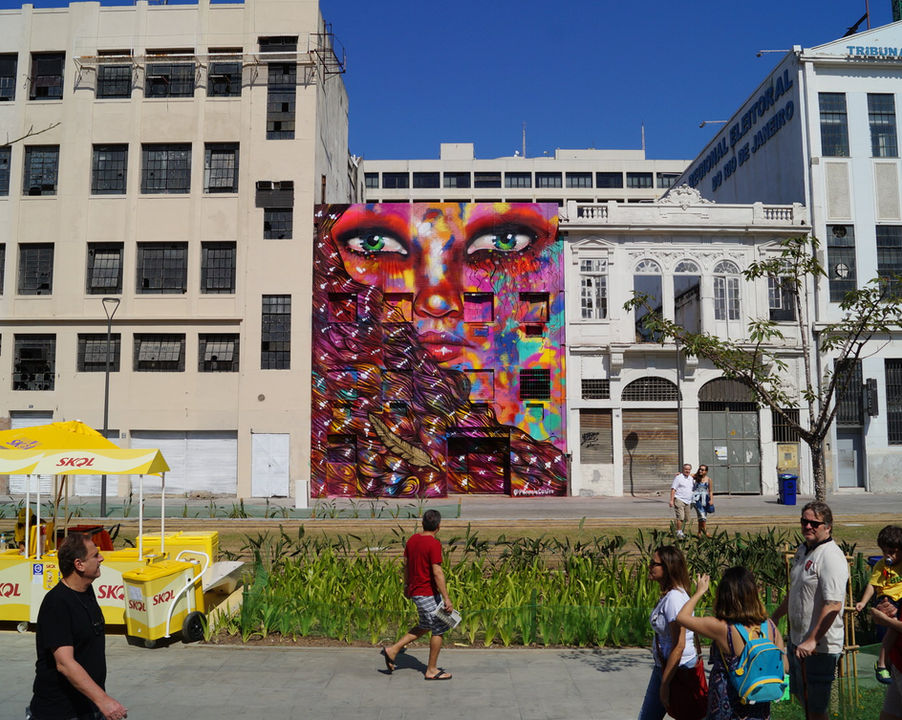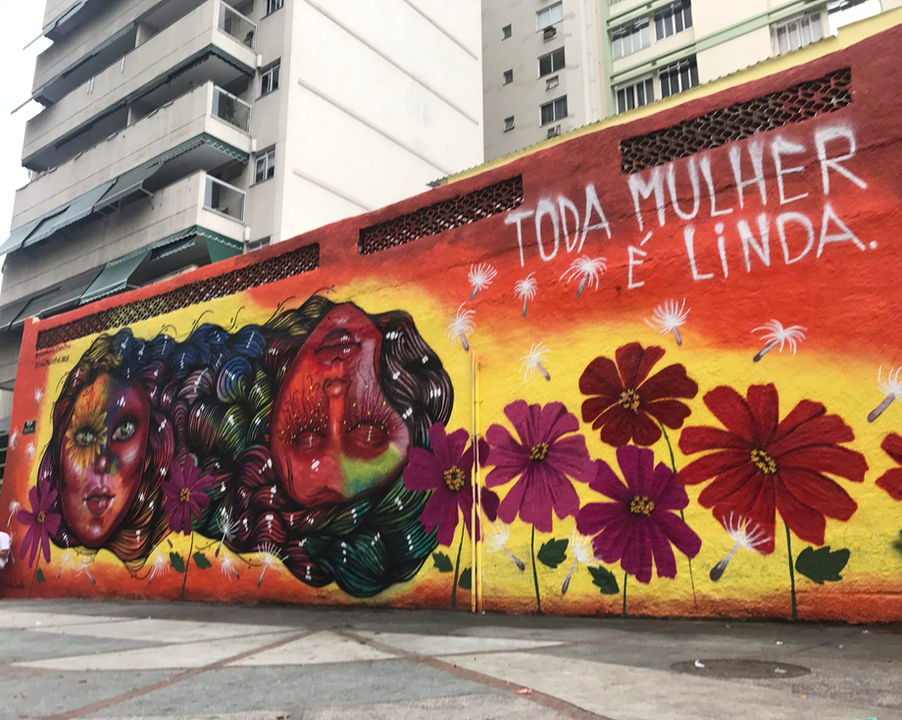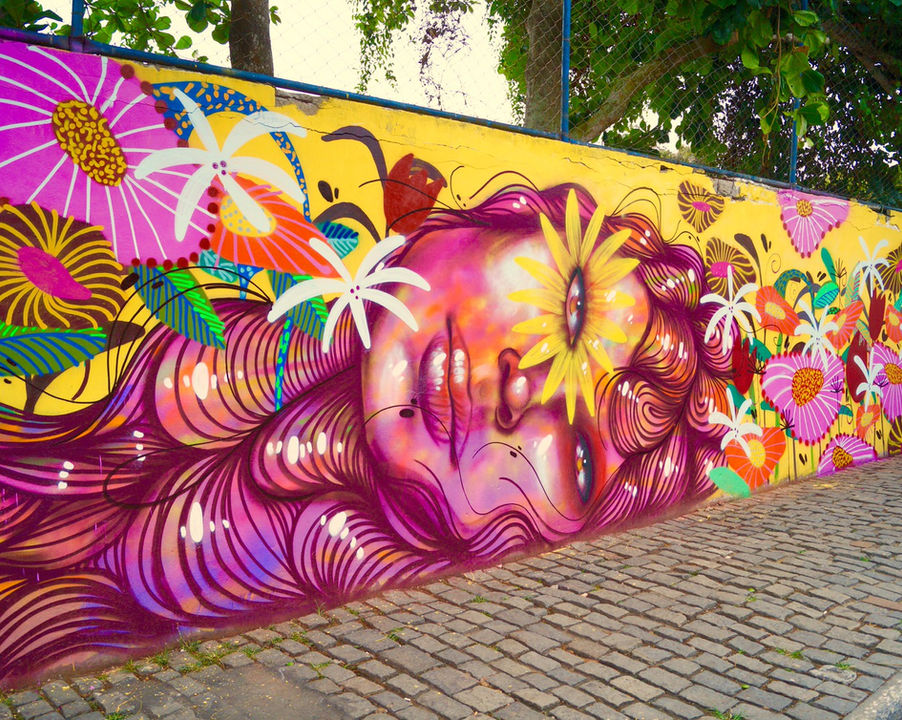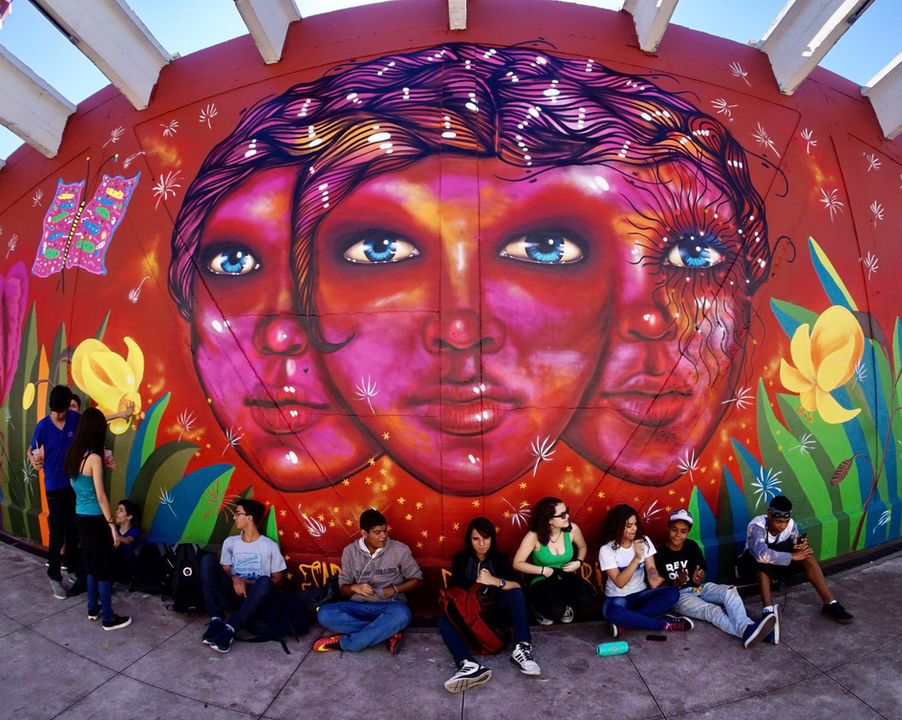Artist Spotlight:
Panmela Castro

Digital Brazil Project: What was your first encounter with graffiti, and what motivated you to do graffiti?
Panmela Castro: From the time that I was a really young child, my family considered me to be an artist. But my mother raised me trapped inside the house, so I could not go out, I could not go to parties, and I could not meet other people. Finally, when I went to college, at the age of 17, only then did my mother said that I was now an adult. I
Interview with
Panmela Castro
could finally do things. So, one of those things was making graffiti, that at the time was not even graffiti, with paintings and the form that we know today, at the time it was pixacão. It was the signatures, you know? So, I got involved with a group of pixadores. Being with them was a way for me to re-socialize; a way to make friends, a way to be invited to go out to places, right? So, it was like that. I started with pixação. Later on, after I got married, I was in a domestic violence situation, and I was beaten by my partner. And again, I couldn't leave the house because he stalked me. So, to recover from that, I used graffiti to re-socialize myself again.There was a group of guys who went out tagging and I went out with them. It was when I could go out because as I was in this group of men, they protected me and I was no longer afraid of my ex-husband stalking me. By then, my graffiti was of images rather than tagging.
Women send me their stories and I paint their portraits.
"
"
Digital Brazil Project: What is your artistic process like?
Panmela Castro: I went through several phases. The image on the wall at any given time came from what I was living. For example, lately I've been painting portraits of women’s stories. Women send me their stories and I paint their portraits. I also like to paint the women who have contributed to the fight for rights. This year I painted Lélia Gonzales, who is a very important black Brazilian intellectual in our history. I was inspired by her work to paint a portrait of her.
Digital Brazil Project: How has your style changed over the years?
Panmela Castro: My style of painting has changed so much as well as the content because I've painted so many different things. I've painted graffiti lettering. There was a time when I only did self-portrait caricatures. There was a time when I painted women from my imagination who did not exist. I painted women tangled up in their hair. And now I'm painting these women with well-known stories. And in terms of the style, of the way I paint walls, it’s the same thing. I had to adapt the paintings because of the fact that it was done outdoors. So there is interference from the sun, the rain, the place you are in, if it’s very hot, if there's too much noise. So, at first, I was trying to make the graffiti very shaded and very realistic. There came a time in 2007, more or less, I used to make the graffiti very realistic. At the time, you didn't have any other Brazilian graffiti artist who had the same technique that I had to make it so realistic. I was the best graffiti artist they had really. Then I saw that this style was actually not so important for the idea I wanted to get across. And since I was going to paint in small towns in the countryside, I often didn't have the resources to do realistic work. For you to be able to do realistic work, you have to have several cans of spray paint, so I adapted the painting so that I could do it with any material. I started to make these colorful paintings. I used the leftovers of multiple color spray cans and sprayed all over the wall with multiple colors and blotches and after I just outlined it in black. For almost ten years I did this kind of painting, which was an easy painting, it did not take a long time, and so that I wouldn't wear myself out on the street and I
could do it with any material. These days my condition is very different. Today I am a 40-year-old woman. My body can't handle doing the same things I did when I was younger. These days I have more structure to do the paintings, you know? So I made my process more complex again because I usually paint under better conditions. So nowadays, I use the brush and work a lot with watercolors. Nowadays I don't make the graffiti as colorful as before. Before I used to make it so colorful so that it could compete with the other forms of visual communication present in the city — with the advertisements, with the logos, with the city’s pollution. I used to make it very colorful, very big, to call attention to many other things. Not now. Now I have been
Before I used to make it so colorful so that it could compete with the other forms of visual communication present in the city — with the advertisements, with the logos, with the city’s pollution. I used to make it very colorful, very big, to call attention to many other things. Not now.
"
"
making pieces with earth tones that don't irritate your eyes so much, that are pleasant to see, and that you don’t get sick of, and so that color doesn't startle you, because my murals now usually are in places that people care for, that people pass by. For example, last year I did a wall of graffiti at the University of Worcester in a room where people studied and passed by, so if it was a very colorful graffiti there, it would be a nuisance because it would be shocking to the eyes. So, with colors that are more muted it harmonizes better with the space. Nowadays, the paintings I do are not a fight for space in the city, but create a harmony with the city, with the space.

Digital Brazil Project: What does it mean to you to paint in public spaces and make artistic interventions in various parts of the world?
Panmela Castro: The positive part of painting in an open place is that your artwork reaches all people regardless of gender, social class, religion, sexual orientation. It reaches out to all people equally. It has a very great power of communication and dissemination. It reaches many more people than traditional art, which is so elitist and used to maintain elite power. So much so that graffiti artists suffer prejudice from the art market and from institutions, like museums, galleries. Today you even see a few
street artists exhibiting in these spaces, but they are smaller in number. Usually, it's more contemporary art people. But our inclusion is fair because graffiti is very popular. It speaks to the masses whereas traditional art is a type of elitist art that is used to add value to those who have money that can buy the works at high prices . Urban art is offered for free to the population. It fulfils its role of transforming people's lives because it reaches people.
Urban art is offered for free to the population. It fulfils its role of transforming people's lives because it reaches people.
"
"
Digital Brazil Project: On a related note, what is the role of graffiti in the world?
Panmela Castro: I think that graffiti comes along with the movement, the art movement, that gives this access, as I was saying, to many more people. It has been used as a powerful communication tool for protests, to bring messages to people, and to bring about positive social transformation. One example that we have is the Black Lives Matter movement itself, in that street, Black Lives Matter Plaza in Washington, DC. They made a mural on the ground with the words of the campaign so that everyone could see and so it could be memorable in people's lives. So, since the mural is reaching these people, it has great transformational power. It is a very powerful tool for talking and debating the issues of the world.
Digital Brazil Project: On one hand graffiti is becoming more accepted globally, and on the other cities continue to criminalize it. What is the situation for graffiti artists in your hometown, Rio de Janeiro?
Panmela Castro: Actually, Brazil is farther ahead on these issues than most other countries. In 2001, we won a federal law that decriminalizes graffiti, so graffiti is no longer a crime. However, for you to do the graffiti, you still have to have a permit. In 2014, in Rio de Janeiro, we managed to create the graffiti decree collectively and it was approved, where we suggest pre-approved spaces to graffiti in Rio de Janeiro.This happened after the painting by Os Gêmeos, who are the most famous graffiti artists in the world, was removed by the city of Rio de Janeiro. That generated a huge scandal and there was a committee that created this graffiti decree, which was even my suggestion. Public walls should be pre-authorized for graffiti. That decree is even in force to this day. I think it's the city's obligation to keep the city clean. If you go to other cities in the world, there are projects to keep them organized and clean. What I think needs to be done is to regulate what a mural is, what to leave up and how to leave it. I think it’s a public policy issue.
Digital Brazil Project: Can you tell us a little about the relationship between your activism and your art?
Panmela Castro: Yes, I founded an organization called Redi NAMI in 2010, which is pretty well known. It’s an organization that uses graffiti to promote women's rights. My artwork is more subjective. It doesn’t have a direct intention to make a change like a pamphlet. It addresses things, it makes you reflect. But the art is much more to feel, and the person comes to realizations within themselves. Now my work in Redi NAMI, in my organization, is a job that more directly creates change. It really changes people's lives because we work with art education. In the organization, graffiti is just a tool to take the issue of women's rights to women. It’s a means of doing that, it's not the end.
In the organization, graffiti is just a tool to take the issue of women's rights to women. It’s a means of doing that, it's not the end.
"
"
We have several projects within the organization. For the first one, “Graffiti for the End of Violence against Women,” I developed a three-hour methodology for conducting a workshop where we talk for one hour about the issue of gender, the types of domestic violence, and promote the Maria da Penha Law, which is a Brazilian law that protects women who are victims of domestic violence. This project goes to schools, goes to the community, talks to women, young boys, and girls. It's preventive work so that they can understand these issues, because many people experience violence and they can’t even identify it as violence. We raise these issues through the graffiti of the youth. At the end we invite the participants to paint a mural on this theme and the mural remains on the wall, multiplying the lesson to the community and the school in addition to people sharing in their social networks.

We have “Afro-Grafiteiras” working with domestic violence. We saw that 70 percent of the women who died from femicide were Black women. We decided to work with Black women, the Afro-Grafiteiras, to have a six-month training program in human rights and the arts. So, they study art and learn about human rights.
We have the “NAMI Fund,” we distribute painting and drawing materials so that women can exercise leadership in their work, in their community by leading workshops, investing in their careers. Now the fund has stopped because of the pandemic. We are using money from the fund to distribute basic food baskets to families in need. Then our students apply, receive a number of basic food baskets and deliver them to their community.
We have an “InterNAMI,” which takes the participants to important spaces, like museums and cultural centers, for them to talk with the leaders of these places.
We also have an open-air museum, you know, because Brazil started having this problem with globalism and started to fight against some issues like gender and feminism, and so there started to be a lot to of discrimination in schools. So, we took the time to go to the schools to do work on the Maria da Penha Law about domestic violence. We set up an open-air museum inside the favela where our office is located. There is one kilometer of murals that address various themes, but mainly about domestic violence. We receive groups, mainly young people, students, and while they are visiting the murals, we tell the story of the end of violence against women.

Digital Brazil Project: You are also a performance artist and you use your body in interesting ways, like you’ve cut your hair and tattooed yourself while performing. What does it mean for you to experience your body like that in your art?
Panmela Castro: As I was doing murals on the street, I realized that I was much more interested in my relationship to what I built being in the city — my relationship with others regarding my body, which is a body read as feminine — than in the painting that I left on the wall. That painting that I left on the wall became less important. I saw that those
relationships that I created with my body to produce these paintings were much more interesting, the stories that happened, how I walked there. I began to turn these experiences into art through performances. I was able to transform this experience with my body in the city, or my body with others, into art through artistic performances. Today my work goes deeper into the realm of ideas. The idea can be presented in any medium — either graffiti, a performance, a video, a photo — rather than always having to be a painting, which is a representation of the world. So much that what I paint today is no longer an illustration of an idea. It is the result of something I have experienced. For example, the portraits of these women that I have painted are not only representations of these women on the wall, but the result of the exchange and the relationship that I had with this woman.

Digital Brazil Project: How does your work engage with other art forms that are often associated with street art, such as hip hop, poesia marginal, and dance?
Panmela Castro:
When I started in graffiti, I was a graffiti artist with roots in the hip hop movement. I also used to break dance. So all the culture that guided hip hop influenced my graffiti, too. It was 100% hip hop. In time, it broke off and I think this movement was not just my movement. I already said that this thing that we call street art is no longer the graffiti that originated
from the world of hip hop. That's why I think that street art gets another name, urban art, or street art, because it has gained other characteristics. And I, as an artist, ended up working completely with contemporary art.
These days though my work is no longer part of the urban art circuit, even the men of urban art hate me.
I had a falling out with all of them because I got into a lot of trouble and I fought a lot because the men are so machista and so now they don't even invite me. I'm really boycotted, you know. I am excluded, but on the other hand today I participate more in this circuit of contemporary art exhibiting in museums, in galleries. Today I am participating in an exhibition in one of the largest galleries in Brazil which is the Fortes D'Aloia & Gabriel, and the ICA in Miami just acquired a work of mine, a painting from the series, Vigília . The Museum of Art in Rio also chose a photograph of mine; works that have nothing to do with graffiti. So, these days I work much less with that universe of when I was a hip hop girl, and I work much more on this official circuit.
Yes, I'm working at Rede NAMI on a book that will be released in March called Hacking the Power: Guerrilla Tactics for Artists from the Global South.
"
"
Digital Brazil Project: What are you developing now and what's coming up?
Panmela Castro:
Yes, I'm working at Rede NAMI on a book that will be released in March called Hacking the Power: Guerrilla Tactics for Artists from the Global South. It is a manual for how a girl from 15 to 24 years old can become an artist even though she is Black, living in the periphery, and has little privilege. This is the main project that I have been developing in Rede NAMI now. There’s also my artwork. I keep painting people's portraits. It's been very successful. We have been working to put these portraits in museum collections around the world.
Interview by Kristal Bivona
Translated by Brooke Dolabella


























